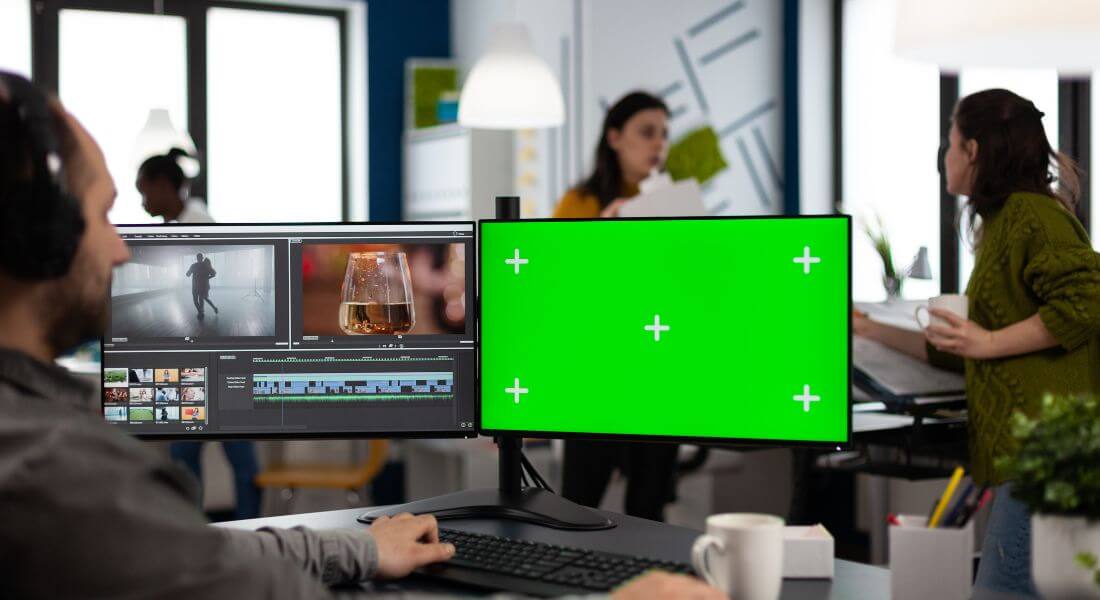
Creating fresh video content for every campaign, update, or social platform is no small task it takes time, resources, and often a full production team. But the good news? You don’t always have to start from scratch. If your archives are filled with previously produced content interviews, tutorials, explainer videos, product demos, event coverage then you’re sitting on a goldmine of material just waiting to be reused.
Repurposing old video content using animation is not only cost-effective, but it’s also an opportunity to rethink how your story is told. By adding motion graphics, animated callouts, updated text, icons, transitions, or even full animated overlays, you can completely transform an older video into something that feels current, dynamic, and on-brand.
Animation lets you tailor existing content to fit new formats like converting a horizontal YouTube video into a vertical Instagram Reel, or refreshing an outdated training video for today’s internal teams. It’s also a powerful way to reach new audiences or reinforce key messages without the added pressure of another shoot day.
In this article, I’ll walk you through creative, practical ways to breathe new life into your past content using animation so you can save time, maximise your video investment, and keep your brand messaging sharp and engaging across every platform.
Add Motion Graphics to Highlight Key Points

One of the simplest and most effective ways to breathe new life into old footage is by layering it with motion graphics. These animated elements whether they’re kinetic text, symbols, charts, or subtle visual cues can draw attention to the most important parts of your message. Beyond just making a video look more modern, motion graphics actually help with information retention, especially in educational or corporate content.
How to do it effectively:
- Highlight key statistics or quotes using animated text that appears as the speaker mentions them. This helps reinforce the message and makes it easier for viewers to follow along.
- Add contextual callouts that explain complex visuals or give viewers additional insights. For instance, if a speaker references a product or process, use a label or pointer to guide the viewer’s eye.
- Use icons, shapes, and brand elements to build consistency and bring a dynamic visual layer to the video. Animated logos or symbols that move with the content create a stronger brand imprint.
Update Messaging with Animated Callouts
Sometimes your old video still carries the right message but small details like the call-to-action (CTA), legal language, or even contact info are no longer current. Rather than re-shooting or heavily re-editing the original footage, you can use animated overlays and callouts to bring the messaging up to date. It’s a quick and budget-friendly way to refresh content while preserving the original visuals and voiceover.
Smart ways to do it:
- Swap outdated CTAs with animated lower thirds or banners. For example, if your video says “Visit our 2022 event page,” you can add a new lower third that points to the current link or updated event name without having to mute or cut the original audio.
- Use animated text boxes to clarify information that has evolved. If policies, pricing, or timelines have changed, you can overlay the new data in a visually appealing way that doesn’t disrupt the original flow.
- Add disclaimers, legal updates, or small clarifications with subtle animations. Think of them like on-screen footnotes they help you stay compliant or accurate without the need for re-recording.
Create Vertical Versions for Social Media
If your original video was produced a few years ago, chances are it was shot in the classic landscape (16:9) format. But today’s most popular platforms like TikTok, Instagram Reels, and YouTube Shorts favour vertical (9:16) video. Instead of letting great content sit unused, you can repurpose horizontal footage into vertical formats using animation and smart editing techniques.
Here’s how to transform your old videos into scroll-stopping vertical content:
- Resize the canvas to 9:16: This is the standard vertical aspect ratio for mobile-first platforms. You can reposition or crop the footage to centre your subject and keep the main action visible.
- Use animated borders or background blur: If the original footage doesn’t fill the vertical frame, you can add animated side panels, branded colours, or a soft blur version of the footage behind the main clip. This keeps the frame full without feeling awkward.
- Add animated text and subtitles: Most social users watch without sound. Use kinetic typography, motion callouts, or closed captions that animate on screen to convey your message clearly. Bonus: this also makes your content more accessible.
- Include animated elements for engagement: Add things like swipe-up prompts, emoji reactions, or branded stickers that pop in and out especially helpful for encouraging action in Stories or Reels.
Break Long Videos into Short Animated Clips

Not every audience has the time or attention span to watch a 5-minute video from start to finish. One of the most effective ways to maximise the value of your old content is to chop it into shorter, animated clips that deliver standalone impact. These bite-sized segments are tailor-made for today’s fast-scrolling platforms like Instagram, LinkedIn, X (formerly Twitter), and TikTok.
You don’t have to reshoot anything just find your video’s best moments and enhance them with simple animation to make them visually distinct and contextually clear.
Here are some creative clip ideas to try:
- Short quotes or soundbites: Extract a powerful line or insight and overlay it with kinetic typography. These 15–30 second snippets are highly shareable and easy to digest.
- Mini product demos: Zoom in on a specific feature or benefit and highlight it using animated arrows, icons, or outlines to guide the viewer’s eye.
- Teaser-style intros: Turn the first few seconds of a long video into a hook with animated transitions and titles, encouraging viewers to watch the full version elsewhere.
- Animated transitions for series-building: Use branded motion elements between clips to string them together into a cohesive mini-series ideal for educational content or multi-part posts.
Short clips not only help amplify reach and engagement, but they’re also perfect for lead nurturing especially when strategically placed in email campaigns or as retargeting assets in social ads. With the right animations, each clip can stand on its own while still contributing to a larger brand narrative.
Animate Data for Fresh Visuals
Data doesn’t have to be dry. If your old video features graphs, charts, or statistics, you can breathe new life into them with animation. Static visuals can often be overlooked or forgotten, but animated data visualisation grabs attention and helps your audience process information faster and more effectively.
Reintroducing facts and figures through motion makes your content feel more current even if the information hasn’t changed. It also boosts engagement by creating a dynamic experience instead of a passive one.
Here are a few creative ways to animate your data:
- Motion bar or pie charts: Instead of showing a chart as a single static image, animate it as it builds up. Watching data grow over time adds visual drama and enhances retention.
- Sequential icon-based infographics: Use simple icon animations to present statistics one by one, keeping viewers interested as new information appears. You can even time these animations to a voiceover for added clarity.
- Side-by-side comparisons: Bring back comparison visuals with sliding transitions, animated ticks and crosses, or colour shifts that highlight pros and cons in a visually engaging way.
- Number counters or progress bars: Animate key numbers with a counting effect or visual progress indicators to highlight metrics like growth rates, sales milestones, or timelines.
Why it works: People remember motion better than stills, especially when it helps explain a concept. Plus, animated visuals feel more intentional and professional perfect for presentations, pitch decks, reports, or re-shared educational content on social platforms.
Add Subtitles and Captions with Style
In today’s scroll-first world, more than 80% of online videos are watched without sound especially on mobile and social platforms. That makes subtitles and captions more than just an accessibility feature; they’re a vital part of video storytelling. But that doesn’t mean they have to be plain or generic. By using animation, you can turn standard subtitles into visually engaging design elements that enhance the overall viewing experience.
Here’s how to level up your captions with animation:
- Timed transitions: Instead of letting your subtitles just appear and disappear, animate them with a soft fade, slide-in, or bounce effect. This makes them feel like part of the video’s rhythm rather than an afterthought.
- Emphasis through movement and colour: Want viewers to really notice a key word or phrase? Use animated text effects like scaling, underlines, or temporary colour changes to emphasise the message without breaking the flow.
- Custom fonts and styling: Ditch the generic subtitle font. Match your subtitles to your brand guidelines by using your official typefaces, colours, and even text box styles. This creates a consistent visual identity even in silent playback.
- Positioning for impact: Experiment with positioning move your captions slightly higher or lower depending on the video’s layout, or place them near the subject for better focus. Animated captions can adapt to visual flow more easily than static ones.
Why it works: Well-designed subtitles not only make your content more accessible to a wider audience (including those with hearing impairments or non-native speakers), but also help reinforce messaging, improve retention, and increase video completion rates.
Turn Testimonials into Animated Case Studies

Customer testimonials and interviews are some of the most trusted forms of content. They provide social proof, build credibility, and give real-world context to your offerings. But let’s face it raw testimonial videos can sometimes feel flat or overly long. That’s where animation can breathe new life into them, turning basic quotes into engaging, story-driven case studies that capture attention and deliver impact.
How to transform testimonials with animation:
- Bring data to life: If a customer mentions performance improvements, sales growth, or time savings, don’t just leave that as a talking point visualise it. Use animated bar charts, percentages, or icon-based infographics to reinforce the success metrics in a clear, engaging way.
- On-screen branding: Add smooth, animated lower thirds to introduce the speaker, along with their title and company logo. This builds instant authority and makes the video feel more polished and professional.
- Dynamic transitions: Instead of awkward cuts between segments or speakers, use branded transitions like wipes, zooms, or motion reveals to guide viewers smoothly from one section to the next. This keeps the pacing tight and the visuals engaging.
- Story structure through animation: Break the testimonial into mini-chapters using animated title cards or on-screen text. For example: “The Challenge,” “The Solution,” and “The Results.” This gives the viewer a clear narrative arc to follow.
Why it works: By layering animation over testimonial footage, you create a more structured and visually stimulating experience. This not only holds the viewer’s attention longer but also helps them retain the key takeaways, especially in B2B or technical use cases where comprehension is critical.
Add a Branded Intro or Outro Sequence
Sometimes, the fastest way to make an old video feel brand new is simply to bookend it with polished, branded animation. An engaging intro and outro sequence not only enhances the professional look of your content but also reinforces brand recognition every time your video plays.
These animated bookends give your content a visual upgrade and ensure that even older footage aligns with your current branding and messaging.
What to include in your animated intro:
- Logo reveal: Use smooth transitions, motion design, or visual effects to animate your logo at the start. This could be a quick fade-in, a build-up using your brand’s shapes or colours, or a more complex sequence that reflects your industry.
- Tagline or series title: If your video is part of a series, include the episode name, number, or topic using on-brand kinetic typography. This helps orient the viewer and makes your content feel part of a consistent collection.
- Custom sound design: Sync your animation with a short music bed or sound effects. A unique audio signature can enhance brand recall, especially when used consistently across content.
And for the outro:
- Strong call-to-action (CTA): Encourage the viewer to subscribe, visit your website, book a demo, or download a resource. Present the CTA as animated text or clickable elements for platforms that support it.
- Contact or social media info: Add animated icons linking to your website, email, or social handles so viewers know where to find you next.
- Closing animation: Use similar motion styles and colour schemes from your intro to bring everything full circle. Consistency in movement and tone leaves a lasting impression.
Why it works: Branded intros and outros serve as visual anchors for your content. They instantly boost production value and give your audience a recognisable entry and exit point which is especially helpful if you’re republishing to new audiences on different platforms.
Create Educational Snippets with Animated Labels
If you have tutorials, webinars, or recorded presentations in your archive, you’re sitting on a goldmine of educational content. These long-form videos can easily be broken down into short, digestible clips that deliver value fast especially when enhanced with animated labels and motion elements.
Animated labels do more than just decorate your clips. They help viewers follow along, highlight key takeaways, and keep your content feeling fresh and engaging.
Smart ways to repurpose educational content:
- Turn complex steps into step-by-step visuals: Add animated labels or text boxes that call out each part of a process. For example, when showing how to use a product feature, label each interaction with arrows, numbers, or brief tooltips.
- Create topic-specific quick tips: Clip out individual teaching moments like a 30-second answer from a Q&A or a single slide explanation and add animated text to reinforce what’s being said.
- Highlight terms or definitions: If your video explains jargon or industry-specific terms, use motion graphics to visually define them on screen as the speaker talks.
Where to use these snippets:
- LinkedIn learning posts: Short, expert-led clips work well for business audiences and establish authority in your niche.
- Instagram Reels or carousels: Educational videos formatted vertically with animated labels can quickly teach something useful ideal for boosting shares and saves.
- Email campaigns or blog embeds: Include 30–60 second clips in blog articles or newsletters to offer value and increase engagement.
Why it works: These bite-sized clips are easier for your audience to consume, remember, and share especially when the visuals guide their attention. Motion cues and animated callouts also improve retention by reinforcing key ideas visually.
Final Thoughts: Breathe New Life into Old Content
Your video library is more valuable than you think. With the right animation techniques, you can turn old clips into dynamic new content for today’s platforms.
It saves time, extends your reach, and reinforces your branding all without picking up a camera.
Get in touch with our animation agency in London to elevate your content through smart, engaging, and budget-friendly video repurposing.

